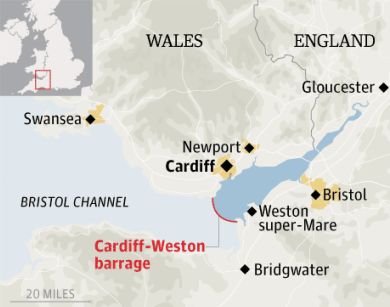
Former Welsh Secretary Peter Hain, MP for Neath near Swansea, has given MPs an enthusiastic account of the proposed design by Hafren Power for a tidal barrage across the Severn estuary twice recently.
The first time was in the Commons debate on the Energy Bill and the second was last Thursday in front of the Select Committee on Energy and Climate Change, which is pursuing an enquiry into the scheme.
I have to declare an interest here: I was commissioned to help write a document advocating the advantages of the scheme at an early stage.
I think it is a very exciting project. But at the same time I want to see any negative environmental effects of the scheme minimised.
It's now well known that this is a completely different proposition from the previous tidal barrage proposal that was rejected in 2010.
For example, it is claimed that the turbines are fish friendly, because they operate at a lower speed, enabling fish to swim both ways through them.
These new turbines will also work on the ebb and flow of the tide, meaning they can generate power 24/7.
Peter Hain told the Committee that the developers, Hafren Power, are prepared to settle for a strike price for the electricity generated that is the same as that received by offshore wind under contracts for difference (CfD). That, if true, is very reasonable.
The claim by the developers is that it will generate 5% of the UK's electricity needs, about the same as three new nuclear power stations and 7,000 wind turbines.
But it will last a lot longer. Like any hydroelectric scheme, it will last for up to 120 years, possibly more, and for most of its life it will therefore produce electricity 75% cheaper than coal or gas. Another considerable advantage.
No Treasury (taxpayers') money will be required to help finance it. However, it will use up a considerable amount of the Levy Control Framework. DECC has already indicated that this could be a concern for other low carbon technologies, for which little money would be left. Why put all one's eggs in one project basket?
The developers claim that the project will remove the need for millions of pounds worth of flood defences being built, because in itself it will protect much of the area from the risk of sea level rise and storm surges. They have even offered to build a Bridgwater bund to protect the Somerset Levels, which are very vulnerable.
However, this money saved cannot be offset against the Levy Control Framework, which is passed on to electricity consumers. There is no way to compensate them for the money saved from not spending on flood defences.
Nor has Hafren demonstrated that the project will protect areas upstream of the barrage from floodwaters coming down river.
It claims that it will generate 50,000 jobs, and on this basis it has won the support of Martin Mansfield, General Secretary of the Welsh TUC and Andy Richards, Wales Secretary for the Unite Union. However there is no supporting evidence explaining how so many jobs can be created.
The Angling Trust is adamant that the technology as so far presented to it is not safe for fish. Other conservation groups equally remain to be convinced.
The Habitats Directive requires that any designated ecology threatened by development must be compensated for elsewhere. In order to comply, the estuary would have to be stripped of its special status by application to the European Commission, a process which could take years due to the scientific evidence that would need to be collected and the natural inertia of the Commission.
Hain, in giving his evidence, was bending over backwards to help appease these objections. The man is staking his reputation as an MP on a private company's single project.
It would be tragic if a perfectly good opportunity to tackle climate change, energy security, promote renewable energy and stimulate the economy to the extent that this project has the potential to, were to be scuppered by the traditional, knee-jerk, objections of the traditional wing of the conservation movement.
After all, it is projected that between 10 and 20% of the habitat within the Severn estuary will be lost due to climate change and other factors anyway, in the future. The barrage proposal claims that 25% will be lost. This leaves a net loss of between 5 and 15%, which is perhaps not so significant when comparing to the environmental benefits.
The company has committed to engage with the Angling Trust, the RSPB and other conservation groups in developing the design. It has invited the Trust to test the turbine with them to see if it is a danger to fish. Together they can perhaps develop an even more fish friendly version of the turbine.
Similarly, a war has been growing between Bristol and Port Talbot ports over their mutual future viability, once the barrage is built, and employment prospects. They need to talk to each other and engage with the project to make sure that everyone benefits and no one loses out.
The project also has the potential to divide the south-west from South Wales, over competition for jobs. Developers must make sure that each side benefits here too.
This is a project with such potentially massive benefits that it cannot be dismissed easily. Its impacts will be correspondingly huge.
All big projects represent big change, and this scares people. They find it difficult to imagine what the finished product will be like and how it will affect the surrounding area.
All affected parties must therefore come together and explore it to see if together they can find a mutually acceptable solution.
It behoves Hafren to listen carefully to them all, to take their concerns on board and work with them.
All of this will take time. But it is the only environmentally and socially acceptable way to proceed.
No comments:
Post a Comment